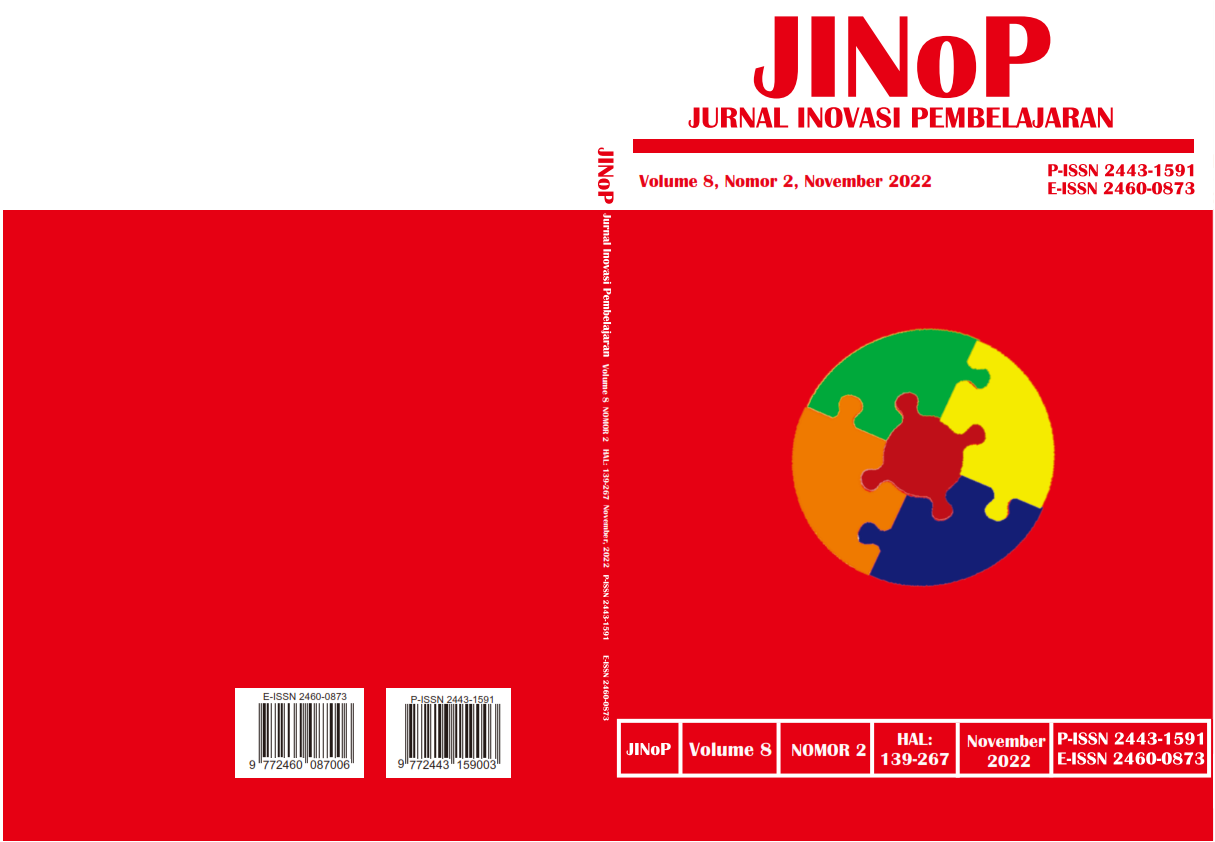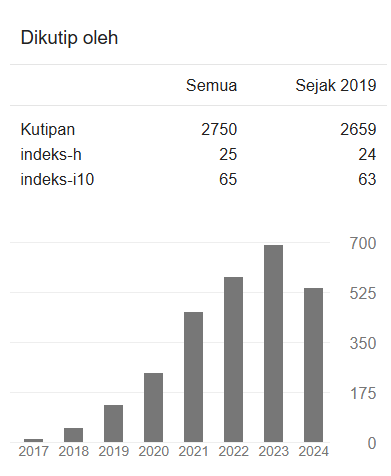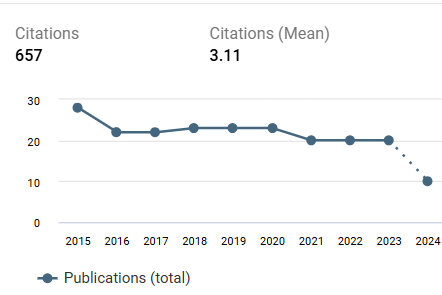Metode demonstrasi pada pembelajaran jarak jauh mata pelajaran gambar teknik di Sekolah Menengah Kejuruan
DOI:
https://doi.org/10.22219/jinop.v8i2.17624Keywords:
Demonstration Method, Engineering Drawings, Learning OutcomesAbstract
The existence of the Covid-19 pandemic is a challenge for learning in vocational schools, especially in practical learning. In the Vocational School of Design, Modeling, and Building Information (DPIB), a Technical Drawing subject aims to prepare students to be skilled at drawing building construction. This research is a Classroom Action Research that aims to determine changes in the learning outcomes of class X students of DPIB skill competence using the demonstration method. This research was conducted in 3 stages: pre-cycle, Cycle I, and Cycle 2. The data analysis showed that at the pre-cycle stage, student learning outcomes only had an average score of 68.653, and 26 of 32 students completed learning. Next, student learning outcomes in the first cycle experienced a relatively high increase of 11%, with an average score of 80.4, with 28 students completed carrying out learning. Then, the test was continued in cycle II with several improvements. At this stage, student learning outcomes increased by 4% from cycle I, with an average score of 84, and 28 students completed learning. The demonstration method is proven effective in applying to Engineering Drawing subjects that are carried out remotely because it can improve student learning outcomes.
Downloads
References
Agustin, M., Puspita, R. D., Nurinten, D., & Nafiqoh, H. (2021). Tipikal Kendala Guru PAUD dalam Mengajar pada Masa Pandemi Covid 19 dan Implikasinya. Jurnal Obsesi : Jurnal Pendidikan Anak Usia Dini, 5(1), 334–345. https://doi.org/10.31004/obsesi.v5i1.598
Aji, W., Dewi, F., Kristen, U., & Wacana, S. (2020). Dampak COVID-19 Terhadap Implementasi Pembelajaran Daring Di Sekolah dasar. Edukatif : Jurnal Ilmu PendidikanJ, 2(1), 55–61.
Damayanti, E., Ahmad, A., Bara, A., Islam, U., & Alauddin, N. (2020). Dampak Negatif Penggunaan Gadget Berdasarkan Aspek Perkembangan Anak. Martabat : Jurnal Perempuan Dan Anak, 4(1), 1–22.
Harsono, B., Soesanto, & Samsudi. (2009). Perbedaan Hasil Belajar Antara Metode Ceramah Konvensional Dengan Ceramah Berbantuan Media Animasi Pada Pembelajaran Kompetensi Perakitan Dan Pemasangan Sistem Rem. Jurnal Pendidikan Teknik Mesin, 9(2).
Jusuf, H., Sobari, A., & Fathoni, M. (2020). Pengaruh Pembelajaran Jarak Jauh Bagi Siswa SMA Di Era Covid-19. Jurnal Kajian Ilmiah, 1(1), 15–24. https://doi.org/10.31599/jki.v1i1.212
Mardapi, D., Hadi, S., & Retnawati, H. (2015). Menentukan Kriteria Ketuntasan Minimal Berbasis Peserta Didik. Jurnal Penelitian Dan Evaluasi Pendidikan, 19(1), 38–45. https://doi.org/10.21831/pep.v19i1.4553
Merfol, F. (2020). Penerapan Metode Demonstrasi Untuk Meningkatkan Kemampuan Siswa Dalam Melakukan Gerakan Mendarat Dengan Dua Kaki Pada Teknik Dasar Lompat Jauh. Jurnal Pendidikan BINANIAGA, 01(01), 21–34.
Milfayetty, S., & Putri, U. N. (2020). Memberi Penguatan Pada Guru Menerapkan Mindful Breathing Dalam Menghadapi Pandemi Covid 19 Di Sd Inklusi Jalan Sei Petani No 19 Medan. Jurnal Vokasi - Politeknik Negeri Lhokseumawe, 4(2), 113. https://doi.org/10.30811/vokasi.v4i2.2002
Molina-Azorin, J. F. (2016). Mixed methods research: An opportunity to improve our studies and our research skills. European Journal of Management and Business Economics, 25(2), 37–38. https://doi.org/10.1016/j.redeen.2016.05.001
Nasution, L. M. (2017). Statistik Deskriptif. Jurnal Hikmah, 14(1), 49–55. https://doi.org/10.1021/ja01626a006
Nawangsih, E. T. (2020). Penerapan Metode Demonstrasi Sebagai Strategi Peningkatan Hasil Belajar Pengolahan Dan Penyajian Makanan Indonesiadi Kelas XIA2 SMK Negeri 2 Ponorogo Tahun Pelajaran 2017/2018. Jurnal Revolusi Pendidikan, III(3), 39–46.
Prawiyogi, A. G., Purwanugraha, A., Fakhry, G., & Firmansyah, M. (2020). Efektifitas Pembelajaran Jarak Jauh Terhadap Pembelajaran Siswa di SDIT Cendekia Purwakarta. Jurnal Pendidikan Dasar, 11(01), 94–101.
Prihantoro, A., & Hidayat, F. (2019). Melakukan Penelitian Tindakan Kelas. Ulumuddin : Jurnal Ilmu-Ilmu Keislaman, 9(1), 49–60. https://doi.org/10.47200/ulumuddin.v9i1.283
Pujiasih, E. (2020). Membangun Generasi Emas Dengan Variasi Pembelajaran Online di Masa Pandemi Covid-19. Ideguru: Jurnal Karya Ilmiah Guru Vol. 5, No.1 Edisi Khusus KBM Pandemi COVID-19, 5(1), 42–48.
Putria, H., Maula, L. H., & Uswatun, D. A. (2020). Analisis Proses Pembelajaran dalam Jaringan (DARING) Masa Pandemi Covid- 19 Pada Guru Sekolah Dasar. Jurnal Basicedu, 4(4), 861–870. https://doi.org/10.31004/basicedu.v4i4.460
Rahman, T. (2018). Aplikasi Model-model Pembelajaran dalam Penelitian Tindakan Kelas (K. Saifuddin (ed.); 1st ed.). PILAR NUSANTARA. https://books.google.co.id/books?id=2CenDwAAQBAJ&printsec=frontcover&dq=penelitian+tindakan+kelas&hl=en&sa=X&ved=2ahUKEwjsivmYr5XvAhUKdCsKHRS8CLgQ6wEwCHoECAkQAQ#v=onepage&q&f=true
Sadikin, A., & Hamidah, A. (2020). Pembelajaran Daring di Tengah Wabah Covid-19. Biodik, 6(2), 109–119. https://doi.org/10.22437/bio.v6i2.9759
Saifulloh, A. M., & Darwis, M. (2020). Manajemen Pembelajaran Dalam Meningkatkan Efektivitas Proses Belajar Mengajar Di Masa Pandemi Covid-19. Bidayatuna Vol.03, No.02, 3, 286.
Sandelowski, M. (2000). Focus on research methods: Combining qualitative and quantitative sampling, data collection, and analysis techniques in mixed-method studies. Research in Nursing and Health, 23(3), 246–255. https://doi.org/10.1002/1098-240x(200006)23:3<246::aid-nur9>3.0.co;2-h
Setiawan, A. R. (2020). Lembar Kegiatan Literasi Saintifik untuk Pembelajaran Jarak Jauh Topik Penyakit Coronavirus 2019 (COVID-19). Edukatif : Jurnal Ilmu Pendidikan, 2(1), 28–37. https://doi.org/10.31004/edukatif.v2i1.80
Siregar, A. H. B.-B. A. S. (2018). Pengaruh Metode Demonstrasi Dan Metode Ekspositori Terhadap Hasil Belajar Mengoperasikan Sistem Pengendalian Elektromagnetik (MSPEM) Di SMK Negeri 1 Lubuk Pakam. Jurnal Pendidikan Teknologi Dan Kejuruan, 20(1), 14–23.
Situmorang, H., & Situmorang, M. (2013). Efektivitas Metode Demonstrasi Dalam Meningkatkan Hasil Belajar Siswa Sekolah Menengah Kejuruan Pada Pengajaran Sistem Koloid. Jurnal Penelitian Bidang Pendidikan, 19(1), 28. https://doi.org/10.24114/jpp.v19i1.3044
Susilowati, D. (2018). Penelitian Tindakan Kelas (PTK) Solusi Alternatif Problematika Pembelajaran. Edunomika - Vol. 02, No. 01 (Februari 2018), 02(01), 36–46.
Sutrisno, R. N. A. R. (2016). Perbandingan Motivasi Dan Prestasi Belajar Menggunakan Metode Demonstrasi Dan Metode Example Non Example Pada Mata Pelajaran Menggambar Interior Dan Eksterior Bangunan Kelas XI Teknik Gambar Bangunan (TGB) SMK Negeri 2 Sukoharjo. 1–8.
Tangkas, I. M., & Said, I. (2007). Meningkatkan Hasil Belajar Siswa Melalui Penggunaan Metode Demonstrasi Pada Mata Pelajaran IPA Di Kelas III SDN Inpres Tunggaling. Jurnal Kreatif Tadulako Online, 2(1), 67–81.
Widiyati, A. (2008). Penelitian Tindakan Kelas. JURNAL PENDIDIKAN AKUNTANSI INDONESIA Vol. VI No. 1 - Tahun 2008 Hal. 87 - 93, VI(1), 87–93.
Wu, Y. C., Chen, C. S., & Chan, Y. J. (2020). The outbreak of COVID-19: An overview. Journal of the Chinese Medical Association, 83(3), 217–220. https://doi.org/10.1097/JCMA.0000000000000270
Downloads
Published
How to Cite
Issue
Section
License
Copyright (c) 2022 Ramadhan et al

This work is licensed under a Creative Commons Attribution 4.0 International License.
Copyright Notice
Authors who publish with JINoP (Jurnal Inoasi Pembelajaran) agree to the following terms:
- For all articles published in the JINoP (Jurnal Inovasi Pembelajaran), copyright is retained by the authors. Authors give permission to the publisher to announce the work with conditions. When the manuscript is accepted for publication, the authors agree to the automatic transfer of the publishing right to the publisher.
- Authors retain copyright and grant the journal the right of first publication with the work simultaneously licensed under a Creative Commons Attribution 4.0 International License. that allows others to share the work with an acknowledgment of the work's authorship and initial publication in this journal.
- Authors are able to enter into separate, additional contractual arrangements for the non-exclusive distribution of the journal's published version of the work (e.g., post it to an institutional repository or publish it in a book), with an acknowledgment of its initial publication in this journal.
- Authors are permitted and encouraged to post their work online (e.g., in institutional repositories or on their website) prior to and during the submission process, as it can lead to productive exchanges, as well as earlier and greater citation of published work (See The Effect of Open Access).








